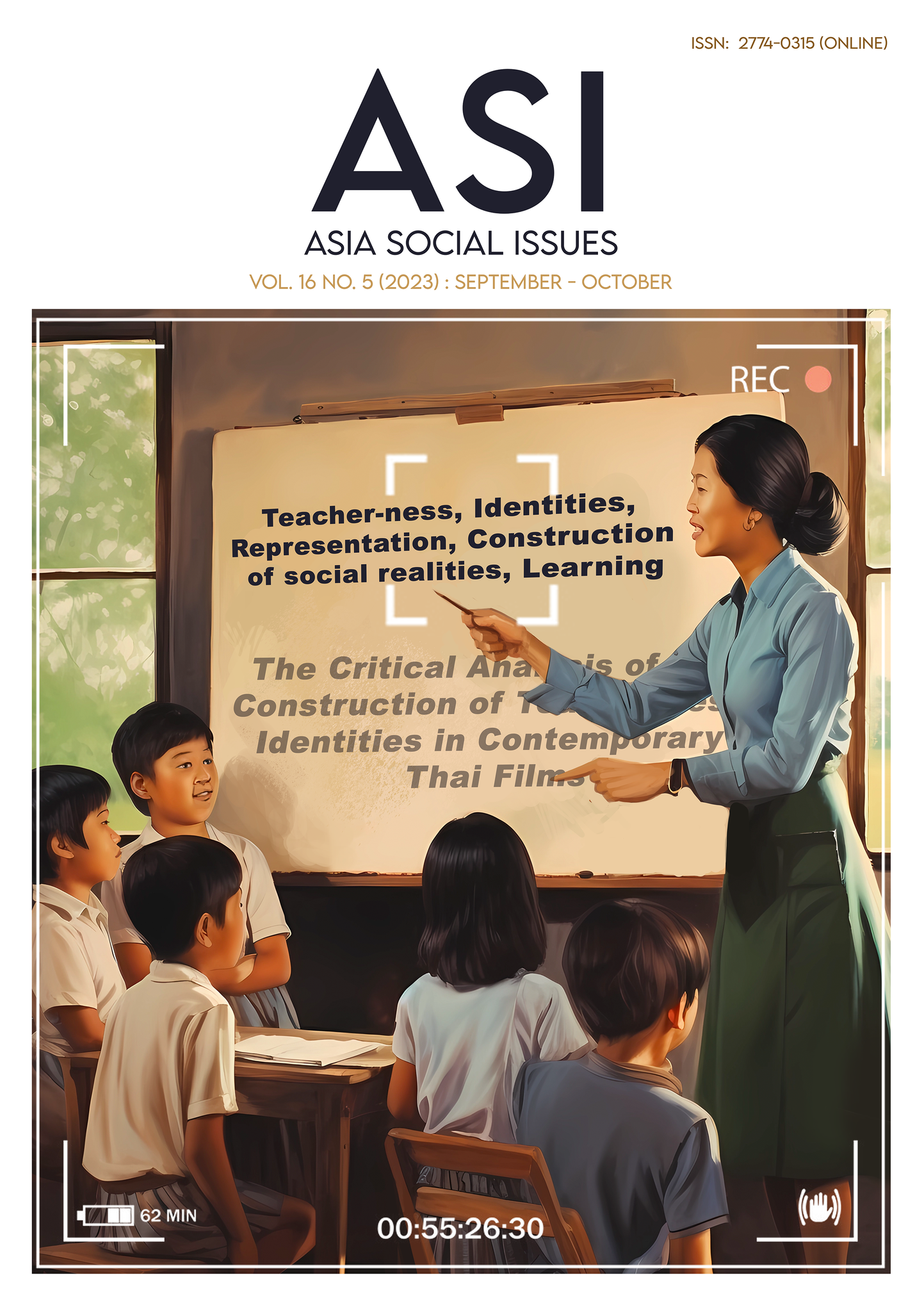Migrants’ Hopes for Longer Stay in Thailand: Gender and Social Space
Main Article Content
Abstract
Thailand has been Southeast Asia’s primary migration hub for the past three decades. Although government policies assume that migrants stay temporarily and only for the time they have official permission, Thai policies, and regulations do not seem to stop migrants from staying longer. This study investigates factors related to migrants’ hopes to stay in Thailand longer than officially permitted by focusing on gender and social space. This study examines the hope for a more extended stay in Thailand of migrants from the three neighboring countries, Myanmar, Lao PDR, and Cambodia, and the relationship between gender, social space of migrants, and expected years of stay. The results show that the hopes of migrants regarding their length of stay varied according to several factors, including gender, age, nationality, type of work, duration of stay in Thailand, and social space. Overall, the average length of stay for migrants was 5.4 years. Regarding social space, it was found that women migrants have more outstanding average social space scores than men.
Article Details

This work is licensed under a Creative Commons Attribution-NonCommercial-NoDerivatives 4.0 International License.
Copyright: CC BY-NC-ND 4.0
References
Achavanitkul, K. (2007). Problems in managing migrants from Myanmar (pp. 132-166). In Jiratikorn, A. (Ed.). Thailand and Myanmar: Precautions what should do or not do. Bangkok, Thailand: Study Area Project 5 regions.
Boonchalaksi, W., Chamratrithirong, A., & Huguet, J. W. (2012). Has permanent settlement of temporary migrant workers in Thailand begun? Asian and Pacific Migration Journal, 21(3), 387-404.
Bylander, M. (2019). Is regular migration safer migration? Insights from Thailand. Journal on Migration and Human Security, 7(1), 1-18.
Conlon, D. (2011). Waiting: Feminist perspectives on the spacings/timings of migrant (im) mobility. Gender, Place & Culture, 18(3), 353-360.
Cresswell, T. (2006). On the move: Mobility in the modern western world.. New York, USA: Routledge
Cresswell, T., & Uteng, T. P. (2008). Gendered mobilities: Towards an holistic understanding (pp. 1-12). In Uteng, T. P., & Cresswell, T. (Eds.). Gendered mobilities. Aldershot, UK: Ashgate.
Deelen, L., & Vasuprasat, P. (2010). Migrant workers’ remittances from Thailand to Cambodia, Lao PDR, and Myanmar: Synthesis report on survey findings in three countries and good practices. Bangkok, Thailand: ILO.
Department of Employment. (2018). Statistical journal of number of foreign migrants in Thailand September 2018. Bangkok, Thailand: Ministry of Labour.
Faist, T. (2013). The mobility turn: a new paradigm for the social sciences? Ethnic and Racial Studies, 36(11), 1637-1646.
Foreign Workers Administration Office. (2018). Royal ordinance. Retrieved from https://www.doe.go.th/prd/alien/law/param/site/152/cat/102/sub/0/pull/category/view/list-label
Gujarati, D. N., & Porter, D. C. (2009). Basic Econometrics Fifth Edition. New York: McGraw-Hill.
Harkins, B. (2019). Thailand migration report 2019. Bangkok, Thailand: United Nations Thematic Working Group on Migration in Thailand.
Huguet, J. W., & Chamratrithirong, A. (2014). Thailand migration report 2014. Bangkok, Thailand: United Nations Thematic Working Group on Migration in Thailand Thailand.
International Organization for Migration and Asian Research Center. (2013). Assessing changes in the migration patterns of Myanmar migrants and their impacts on Thailand. Bangkok, Thailand: International Organization for migration.
Israel, G. D. (2012). Determining sample size. Retrieved from https://www.psycholosphere.com/Determining%20sample%20size%20by%20Glen%20Israel.pdf
Khumya, T. (2018). Sense of place and power geometry of female Myanmar migrant workers in Bangkok, Thailand. Journal of Mekong societies, 14(1), 17-40.
King, R., & Skeldon, R. (2010). ‘Mind the gap!’Integrating approaches to internal and international migration. Journal of Ethnic and Migration Studies, 36(10), 1619-1646.
Kusakabe, K., & Pearson, R. (2016). Working through exceptional space: The case of women migrant workers in Mae Sot, Thailand. International Sociology, 31(3), 268-285.
Lefebvre, H. (1991). The Production of Space, trans. by Donald Nicholson-Smith, Oxford, UK and Carlton. Australia: Blackwell Publishing.
Mandel, J. L. (2004). Mobility matters: Women's livelihood strategies in Porto Novo, Benin. Gender, Place & Culture, 11(2), 257-287.
Meyer, S. R., Robinson, W. C., Branchini, C., Abshir, N., Mar, A. A., & Decker, M. R. (2019). Gender differences in violence and other human rights abuses among migrant workers on the Thailand–Myanmar border. Violence Against Women, 25(8), 945-967.
Phillips, D., & Robinson, D. (2015). Reflections on migration, community, and place. Population, Space and Place, 21(5), 409-420.
Porter, G. (2011). ‘I think a woman who travels a lot is befriending other men and that's why she travels’: mobility constraints and their implications for rural women and girls in sub-Saharan Africa. Gender, place and culture, 18(01), 65-81.
Rigg, J. (2007). Moving lives: migration and livelihoods in the Lao PDR. Population, Space and Place, 13(3), 163-178.
Rouse, R. (1991). Mexican migration and the social space of postmodernism. Diaspora: a journal of transnational Studies, 1(1), 8-23.
Sampson, I. A., Miles, G. M., & Piano, E. (2020). “Undocumented, unregistered and invisible”: an exploratory study of the reasons for and effects of migrating to Thailand of Cambodian young people. International Journal of Sociology and Social Policy, 41 (7), 862-874.
Sheller, M., & Urry, J. (2006). The new mobilities paradigm. Environment and planning A, 38(2), 207-226.
Thongyou, M., & Ayuwat, D. (2005). Social Network of Lao Transnational Migrant Workers in Thailand. Journal of Mekong societies, 1(2), 55-86.
Urry, J. (2011). Does mobility have a future? (pp.3-20). In Grieco, M., & Urry, J. (Eds.). Mobilities: New perspectives on transport and society. Surrey, UK: Ashgate Publishing Limited.
Wiley, S. B. C., Sutko, D. M., & Moreno Becerra, T. (2010). Assembling social space. The Communication Review, 13(4), 340-372.
Yamane, T. (1967). Statistics an introductory analysis. New York: Harper & Row.


